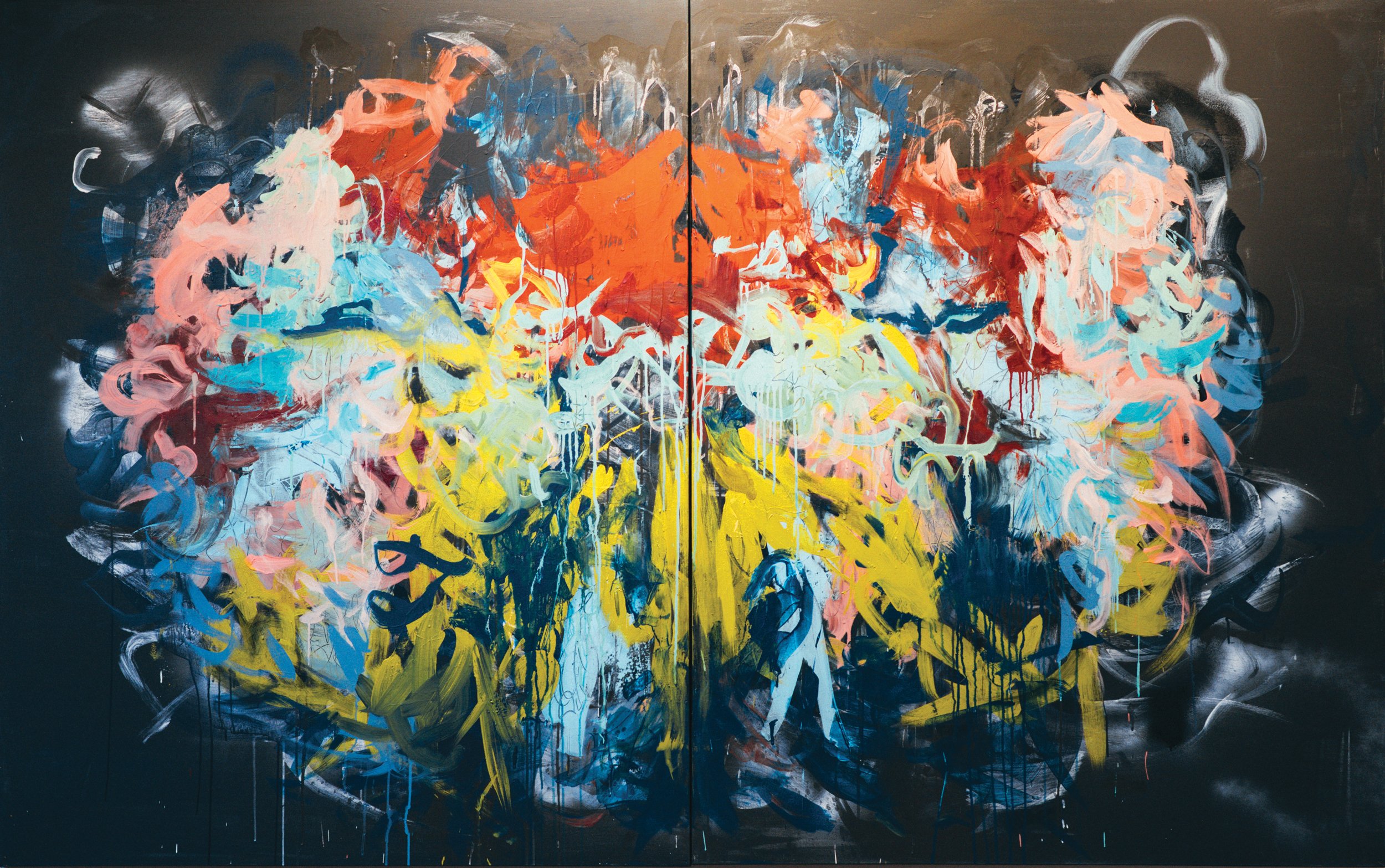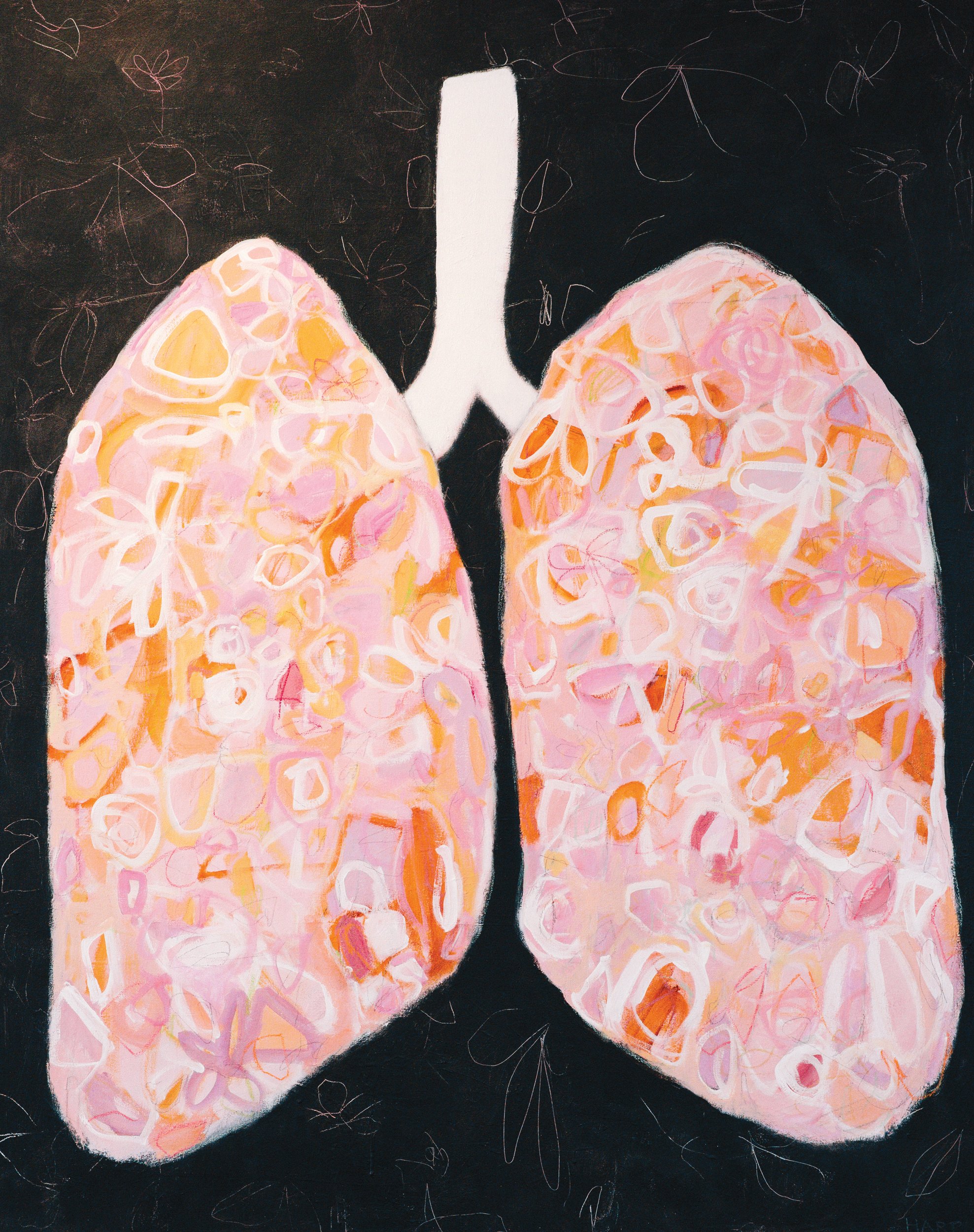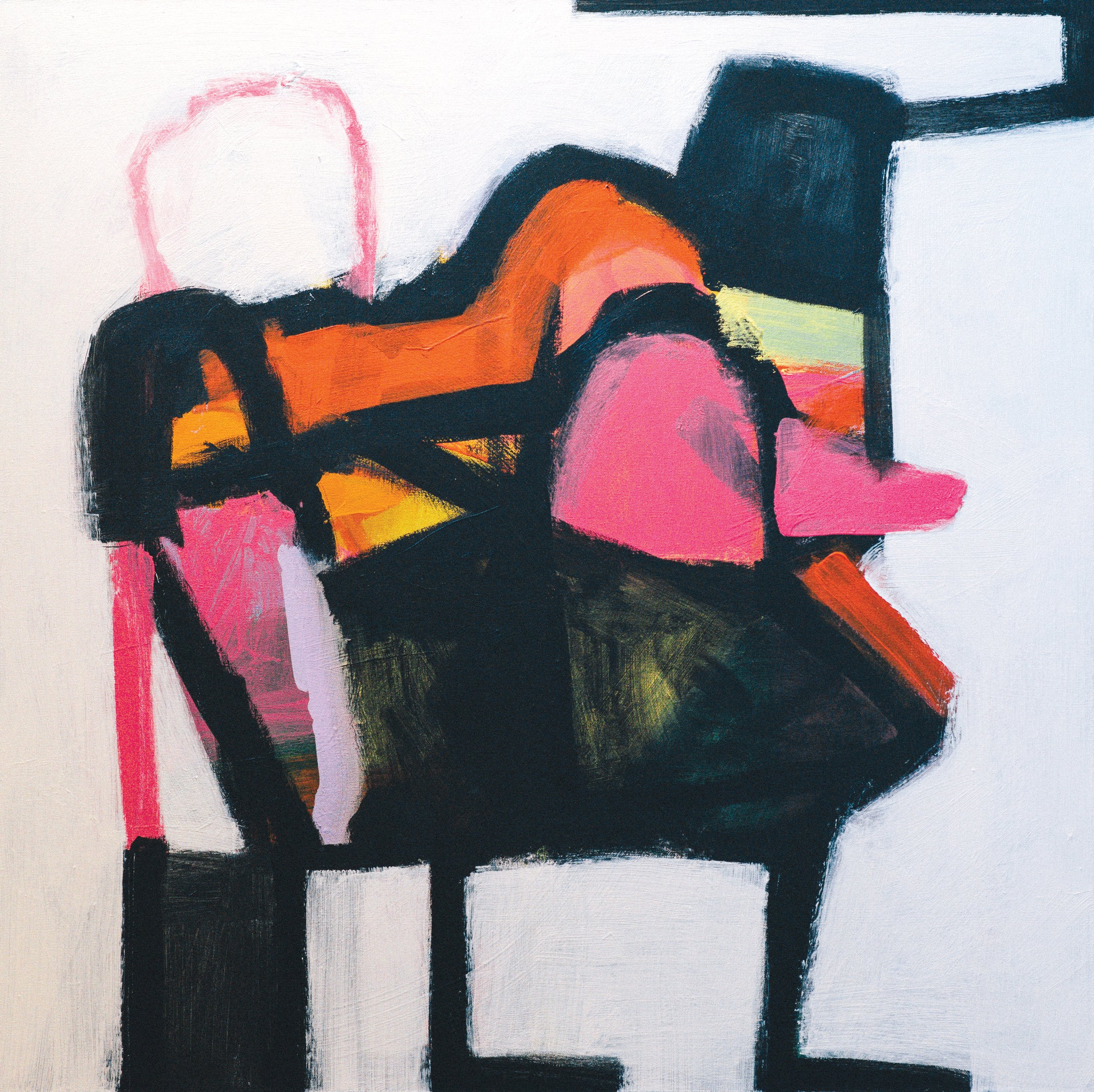Kalico: Art for All
by Megan Crawford
published in Issue No. 7: July/August 2020
Off the Deep End (detail), Heidi Marie Faessel | acrylic paint & spray paint on canvas, 96x60
The beauty of contemporary art is that it can mean something totally different viewer to viewer. With traditional paintings (baroque, renaissance, and the like), people have pretty much come to an agreement on a meaning. But contemporary art is a mirror, not a book— what you see is you, whether it’s a manifestation of you or simply what you see in a painting.
The art world is oftentimes a bubble. It’s inaccessible to many, it can be (and usually is) elitist, and there are sub-cliques within the greater clique of art. But what if you did away with the old system? What if, instead of pitting artists against each other and “non-artists,” you leveled the playing field? An open, unpretentious space for anyone, any age, any skill.
Put that in northwestern Montana and you have Kalico Art Center.
In a state where Western art is bread & butter and anything outside of the genre is often shrugged off, it’s exciting to see contemporary art spaces pop up. But still, it’s common practice for galleries to be exclusive.
As a young woman in art, I know this first-hand. I’ve been turned away from galleries because they hear “photographer” and immediately discount you (if they welcome photography at all), I’ve been told that I don’t know what I’m talking about because I’m young and a woman, I’ve been mistaken as a lab tech and not an instructor— you get the idea. So, when I first walked into Kalico in December 2019 and met Alisha Shilling, Kalico’s Director, I knew this was different.
Right off the bat, we talked about being artists in Montana, which doesn’t have the same platforms you see on the east and west coasts. We talked about being women in art and business, about photography, workshops— and I was just someone that walked in.
Since the Kalispell holiday stroll in December, a few things have changed. I met with Alisha and Michell Wang, Kalico’s Operational Manager, in early March. They were supposed to have their soft opening on March 27th, but the State of Emergency had just been declared. Not long after our meeting, Montana was put on lockdown. There were workshops planned, poetry slams, pottery classes— all canceled at a moment’s notice. They switched gears and prepped curbside pottery and art kits, but when they were deemed nonessential (which eliminated curbside orders/pickup), Kalico had to pivot again.
They worked with local artists and created downloadable coloring pages, hosted online Drink n’ Draws, and revamped their entire website.
One of the hurdles, Shilling noted, was holding space among the swarm of businesses and organizations that released free content— The MET, the MoMA, the Getty, to name a few— a slew of museums that released free online collections, videos, and classes. How do you stand out in a sea of free materials, especially when it’s a lot harder for you to create and release free content?
So Virtual Drink n’ Draws became a weekly staple at Kalico. With different open-ended prompts (as opposed to drawing a set subject along with an instructor), they made a space for everyone.
But, back to the basics: what is Kalico? When I first heard about it in the fall of 2019, I was told that it was going to be a funky, new art space. And while Kalico is funky and new, it goes so much deeper.
“[Kalico is] a community nonprofit art space for people of all ages and abilities to connect, create, and experience art through dynamic classes, workshops, exhibitions, and more,” Wang explains. “We’ve been working on the more part,” Shilling laughs.
The “more” part of Kalico is a whole world of interactive elements— from their take and paint pottery to a walk-in pottery studio, welcome to anyone. “That’s also why I like Drink n’ Draw so much,” Wang notes. “It’s all levels… it’s fun when people surprise themselves. ‘Oh, but I can only draw a stick figure.’”
“And then they draw more,” observes Shilling.
That lightbulb— seeing someone realize their potential or that they are, in fact, an artist, is what drives Kalico. “The vehicle is art— inside that vehicle is the desire to build community and connections. Believing in that ability of yourself to be an artist, reconnecting to that place where you see yourself as innately creative. I think that when we can operate from that space, whether we’re a banker or a lawyer or a mother or a teacher— I think when we operate from that place… we find a lot more joy and peace in our lives.” Anyone, everyone, is inherently an artist, which is one of Kalico’s cornerstones.
Mask Studies, Tessa Heck | gouache, ink on paper, 12x18
But art equity is a common issue— art takes time; it takes money in the form of supplies, lessons, workshops, or a degree; it takes an accessible and open gallery space. In response to school closures, Kalico partnered with the Hockaday and the library and created take-home art kits from supplies they had in anticipation of their original opening. Together, they gave out over 500 art kits.
“If we can get these into the hands of kids right now,” Shilling noted, “they’re at home.” “We don’t know what supplies people have at home,” Wang adds.
For a while, access to art supplies was solely online, which in and of itself excludes anyone without access to the internet. On top of that, several supply websites had reduced stock. Kits from the three organizations went to five local elementary schools and the Heart Locker, a program under local nonprofit Kalispell Heart Program that acts as a donation “store” for students K-12 who struggle with homelessness.
Off the Deep End, Heidi Marie Faessel | acrylic paint & spray paint on canvas, 96x60
Art, especially contemporary art, holds an important space as a platform for the now— a response to the world as it’s happening.
Their inaugural show, Quarantine Dreams, opened on June 5th. Curated by Jenny Bevill, it featured Olivia Stark, Kage Harp, Kelly Moncur, Tessa Heck, and Heidi Marie Faessel. From commentaries on the masks we wear to isolation to loss, the show captured the nuances of covid-19 through the lens of contemporary art. Faessel’s Off the Deep End engulfs the viewer with its sheer size alone (96”x60”), but there’s comfort in seeing your own emotions laid out in brushstrokes— art communicates what we can’t put into words.
In one of the front windows, there’s a torn and safety-pinned black t-shirt made to represent the lives lost in the covid-19 pandemic— the clothes that won’t be worn again, the empty spaces. Faessel’s Lost Time is in the corner of your eye as you walk from piece to piece, with rays of light leaking through the gaps and seams, quietly reminding you that it’s there.
From a painting of a pair of lungs (Harp’s Just Breathe) to a sculpture that seems to watch your every move (Moncur’s Skeptica), it’s an exhibition that makes you feel seen. Through the vehicle of art, it’s what we’ve all been collectively, but separately, feeling— loneliness, worry, fear, and the inexplicable things that best articulate themselves through the visual form. Heck’s mask studies feel like a series of mirrors, and Stark’s abstractions capture how we can look at the same subject but walk away with different interpretations and experiences. Despite the difficulties of hosting an exhibition with state restrictions, Kalico created a safe space for the conversations we’ve been afraid to have.
In the wake of George Floyd’s murder, the board looked at how they could put action and money where their talk is. “I’m proud of all of us— the board and the artists for Quarantine Dreams for having those conversations. Having space for those conversations… it’s a work environment I want to be in,” says Wang. As part of the Operations team, Shilling and Wang watched as the board worked, starting with the national level and scaling down to the local community.
Continuing to work with the community, Kalico plans to create micro-grants for BIPOC (Black, Indigenous, people of color) artists. “We wanted to figure out a way to keep with that mission of the intersection of art and community,” says Shilling. A call for work from BIPOC artists would have the micro-grants as a sidecar. “If you’re not able to access the materials— the canvases, the paints— if there is a hurdle for you to even get to the point to be in a show, can we remove a hurdle before the show? Maybe you already have the supplies, and [the grant] pays for your time.”
Just Breathe, Kage Harp | mixed media, 48x60
For Kalico, it was important to build a neutral, flexible space for the art community— from poetry slams to living room concerts to art shows to workshops. To have a creative hive where people can come together and feed off of each other’s works and imaginations is imperative to art. A space where you don’t have the immediate upfront cost that comes with college classes, where you can dip your toe into the art pool before you dive in headfirst. Where the community can come together and connect through art in all its forms.
Winter Roost, Olivia Stark | acrylic on canvas, 36x36
Ephemera, Kelly Moncur | shoulders 15 ; length 36







